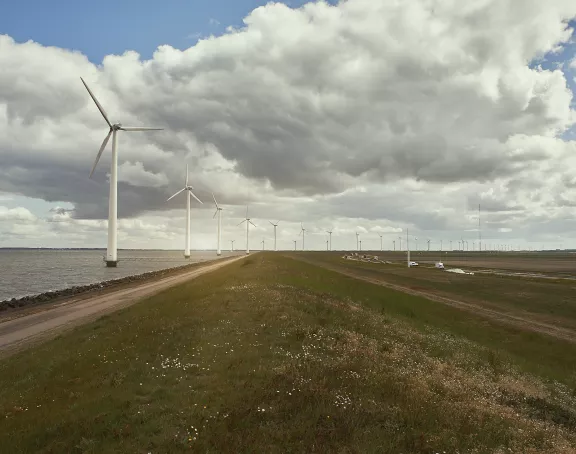The European Climate Law explained
Co-legislators on the European Climate Law reached a provisional agreement on April 21, 2021. This Climate Law is one of the key elements of the European Green Deal, published by the European Commission in December 2019. The overarching goal of these instruments is to achieve a climate-neutral Europe by 2050. The European Climate Law ensures that this climate neutrality goal is enshrined in a European regulation. This blog post takes a closer look at the European Climate Law and explains what it entails.
We will first discuss the background of the European Climate Law, including the Paris Agreement. We will then introduce the European Green Deal and the European Climate Law including the current state of affairs and the objectives of the Climate Law. We conclude this post with some final remarks.
Background: The Paris Agreement
When speaking about the impact of climate change, the Paris Agreement is a common reference. This agreement is the result of the 2015 Paris Climate Conference. On April 22, 2016, the international Paris Agreement on climate change was signed by the contracting States and was ratified by the European Union in October 2016. A key component of the Paris Agreement is Article 2, which sets the goal to hold the increase in the global average temperature to well below 2°C above pre-industrial levels, and to pursue efforts to limit the temperature increase to 1.5°C above pre-industrial levels.
European Climate Legislation
The European Green Deal
After ratifying the Paris Agreement, the European Union had to get to work. In December 2019, the European Commission published the European Green Deal, with the overarching aim of making Europe climate-neutral by 2050 and emitting net zero greenhouse gases from that point on. In this Green Deal, the Commission covers a variety of elements; for example, the Green Deal presents an aim to make the transition to a circular economy, in which the business community must be mobilised, as well as aims to achieve clean energy and a toxic-free environment. Finally, one of the core elements of the European Green Deal is the European Climate Law. A provisional agreement on this Climate Law was reached on April 21, 2021.
The European Climate Law
Current state of affairs
On March 4, 2020, the European Commission tabled its proposal for a European Climate Law (to be laid down in a directly applicable regulation), which was then amended on some minor points on September 17, 2020. On April 21, 2021, news broke that a provisional agreement had been reached between the European Parliament and the Council on how the goal of the European Union to achieve climate-neutrality by 2050 would be enshrined in binding legislation. This will make this goal a legal obligation.
Content of the proposal of the European Climate Law
The European Climate Law outlines a framework for the irreversible and gradual reduction of greenhouse gas emissions and legally establishes the goal of a climate-neutral Europe by 2050.
The European Climate Law does not yet define precisely which measures the Union institutions and Member States must take to move towards a climate-neutral Europe by 2050. However, the Climate Law does set the direction of travel towards the goal. This is because the European Climate Law provides a basis for the adoption of delegated acts. In those delegated acts, it will also become clearer what the concrete consequences of the European Climate Law will be for other actors than the Union and the Member States (such as businesses). Furthermore, the European Climate Law defines what should be taken into account when adopting these delegated acts, for example the competitiveness of the EU economy (i.e. the level playing field), and the best available techniques. In addition, Member States must prepare and implement adaptation strategies and plans.
The European Climate Law also introduces measures for monitoring progress. Every five years, the European Commission will evaluate the collective progress and the measures available, and, if necessary, will take such measures. In short: a definite dot on the horizon, but no concrete measures yet.
The provisional agreement
The European Commission has outlined the aspects on which the provisional agreement was reached between the European Parliament and the Council. These are highlighted below.
- Based on an extensive impact study, the Commission has proposed a more ambitious 2030 target: at least 55% reduction of net emissions as compared to 1990, instead of a reduction of “only” 40%. An agreement has been reached on this reduction target of 55% by 2030.
- Enhancement of the EU’s carbon sink.
- A process for setting a climate target for 2040.
- A commitment to negative emissions after 2050.
- The establishment of a European Scientific Advisory Board on Climate Change.
- A clearer focus on climate adaptation, to make sure that Europe will adapt to the inevitable consequences of climate change
- A focus on a strong coherence across Union policies so that these instruments can also contribute to the climate neutrality goal. The Commission will determine by June 2021 whether these instruments need to be revised.
- Engaging with different sectors.
Conclusion
From the foregoing, it is clear that the European Climate Law strengthens and legally enshrines the goal of a climate-neutral Europe by 2050. More importantly, the European Climate Law provides the frameworks for the instruments to actually achieve those goals, and provides a possibility for the Commission to intervene if it appears that Member States are falling behind schedule. In addition, a provisional agreement was reached on this Climate Law in April 2021, in which agreement was reached on a large number of important aspects. On the one hand, the Climate Law can be seen as a vehicle to more detailed measures. On the other hand, it can also be seen as a “paper tiger” that leaves out exactly how we are going to get there. Therefore, we are curious to see whether this is really the first step towards realizing the ambitions of the European Commission.
For more information, visit our website: Energy Transition and Climate.

